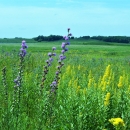Visit Us
National wildlife refuges offer us all a chance to unplug from the stresses of daily life and reconnect with our natural surroundings. Agassiz National Wildlife Refuge is located in northwest Minnesota. Packs of wolves, moose, waterfowl and 300 species of birds make this refuge a wildlife wonderland.
Driving Directions
The refuge headquarters is located on Marshall County Road 7 (290th Street NE), 12 miles north of Thief River Falls and 11 miles east of Holt, Minnesota.
Fees
There is no charge to visit.
Restrooms
Restrooms are available inside the refuge headquarters and visitor contact station. Two comfort stations are also available, one at the headquarters parking lot and another at the southwest corner of the refuge near the entrance to Rodahl Hiking Trail.
Points of Interest
There are kiosks located near both the east and west refuge entrances to welcome you and provide the information needed to give you a good start to exploring the refuge. There is also a kiosk located in our headquarters parking lot. If you’re visiting during our office hours, let our staff at the visitor contact station help you plan your visit! This is a great starting point for visitors to become more familiar with the refuge and the wildlife that live here.
What To Do
If you have 15-minutes
- Stop by the visitor contact station
- Enjoy the view from the Parker Pool observation deck
- Take a quick stroll on the headquarters hiking trail
If you have one hour
- Take your time hiking one or two of the three trails
- Take the four-mile Lost Bay Habitat Drive
Know Before You Go
When planning a trip to the refuge, it is important to wear appropriate footwear for hiking and to dress for the weather. Consider bringing water, food, binoculars, field guides, a hat, sunscreen, insect repellent and anything else that might make your outdoor experience more enjoyable.
Visitor Tips
Wildlife observation opportunities are best in the early morning or late afternoon hours, when animals are foraging for food. The diversity of waterfowl species that flock to the refuge is one of the main attractions for visitors.
Waterfowl observation periods
- Canada geese and trumpeter swans start arriving in mid-March
- Ducks start arriving in early April
- May through mid-June is the best time to observe ducks, when their colorful spring plumage makes identification easier
- Goslings can be observed as early as the first week in May, and ducklings as early as the third week in May
- Peak fall populations of Canada geese and ducks occurs from late-September through October
Other popular viewing opportunities
- Sandhill Cranes: April 25 - May 5 and September 25 - October 10
- Franklin’s Gulls: May 1 - July 15
- Warblers: May 15 - 25
- Sparrow species: May 15 - 25
- Shorebirds: May 20 - 30 and August 15 - September 15
- Moose Calves: May 15 - June 15
- Moose Rut: September 15 - October 31
Activities
The refuge offers a self-guided auto tour drive, three hiking trails and observation decks with spotting scopes, all which provide visitors opportunities for nature study, wildlife observation and photography. All are open from May through mid-October during daylight hours. It's always good to call ahead if planning a trip to make sure facilities are open and available.
For a true bird’s-eye view of the refuge and surrounding area, visitors can climb the 100-foot tower located near headquarters. You can obtain a key for the tower during office hours during snow-free months.
Other Facilities in the Complex
In addition to the main refuge, staff at Agassiz National Wildlife Refuge also manage two units of the Northern Tallgrass Prairie National Wildlife Refuge and a 510-acre Waterfowl Production Area.
Northern Tallgrass Prairie National Wildlife Refuge was established in 2000 to address the loss of America’s grasslands and the decline of grassland wildlife. This refuge encompasses all or part of 85 counties in western Minnesota and northwestern Iowa.
The units managed by Agassiz National Wildlife Refuge staff are located in Kittson County. These tracts of land are aspen parkland habitat, which is a transitional zone between the coniferous forest and tallgrass prairie habitat.
The Walton Waterfowl Production Area was purchased in 2012 using Federal Migratory Bird Hunting and Conservation Stamp dollars. The stamp, commonly known as the Duck Stamp is what waterfowl hunters are required to have in their possession while hunting. This property provides nesting habitat for a variety of waterfowl, grassland birds and other wildlife. This property also helps reduce erosion, clean and protect ground water and reduce flooding
Rules and Policies
To ensure your safety and protect wildlife and habitat, please be aware of these regulations.
General Refuge Regulations
- Open during daylight hours only (sunrise to sunset)
- Dogs and other pets must be kept on a leash at all times
- Hiking allowed on designated trails - please see the map
- Obey posted speed limits
- Please pack out your trash
- No overnight parking, camping or fires are allowed
- Off-road vehicles (including snowmobiles), trail bikes, horses and dogsleds are not permitted
- All watercraft (motorized and non-motorized) are prohibited
- Launching, landing, or operating an aircraft to include unmanned aircraft (drone) is not permitted on refuge property
- Collecting, removing and disturbing plants, animals and/or their parts is prohibited (for example, shed antlers, berries and mushrooms)
Locations
The refuge headquarters is located on Marshall County Road 7 (290th Street NE), 12 miles north of Thief River Falls and 11 miles east of Holt, Minnesota.
